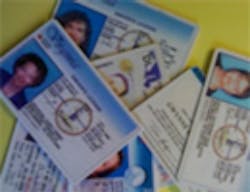The U.S. Department of Homeland Security (DHS) has announced a final rule setting uniform standards for drivers’ licenses and identification cards, in an attempt to strengthen safety and security procedures and protect against terrorism. “REAL ID” cards are scheduled to begin to go into effect in 2009.
“The American public’s desire for greater identity protection is undeniable,” said Homeland Security Secretary Michael Chertoff. “Americans understand today that the 9/11 hijackers obtained 30 drivers licenses and ID’s, and used 364 aliases. For an extra $8 per license, REAL ID will give law enforcement and security officials a powerful advantage against falsified documents, and it will bring some peace of mind to citizens wanting to protect their identity from theft by a criminal or illegal alien.”
According to the Federal Trade Commission, identity theft increased nearly 800% from 2000 to 2006, and DHS said REAL ID would address the issue through setting requirements states must adopt.
These include information and security features incorporated into each card, proof of identity and U.S. citizenship or legal status of the applicant, verification of the applicant’s source documents, and increased security standards for offices that issue licenses and identification cards.
However, many groups deem the program ineffective and costly, and fervently oppose the plan. The American Civil Liberties Union’s (ACLU) Barry Steinhardt and Tim Sparapani said in a statement: "REAL ID needs to be repealed. It is not only a threat to Americans' privacy but it is utterly unworkable. After 3½ years of efforts to implement this law, the tortured remains of the statute that appear to survive in these regulations stand as stark evidence of that fact.”
Numerous state governments have challenged the idea of a national ID card, with some attempting to block the legislation.
“Rather than improved security, this course will result in resentment, litigation, and enormous costs that states will be forced to absorb,” said Senator Patrick Leahy (D-VT). “That is why legislative bodies in 21 states have passed legislation in opposition to REAL ID, and six states expressly prohibit compliance with REAL ID by statute -- Maine, Montana, New Hampshire, Oklahoma, South Carolina and Washington. The Administration would do much better to treat the states as partners, and forego the paternalistic mandates that the American people are rejecting.”
“I have joined Senators Akaka, Sununu, Tester, Baucus, and Alexander in introducing legislation to repeal the drivers' license provisions of the law, and to replace them with the negotiated rulemaking process originally enacted in the 2004 Intelligence Reform and Terrorist Prevention Act,” Leahy added.
Compliance for the REAL ID program is set to begin on December 31, 2009. All individuals under the age of 50 will be required to complete enrollment by December 1, 2014, and all individuals over the age of 50 will be required to enroll by December 1, 2017.
